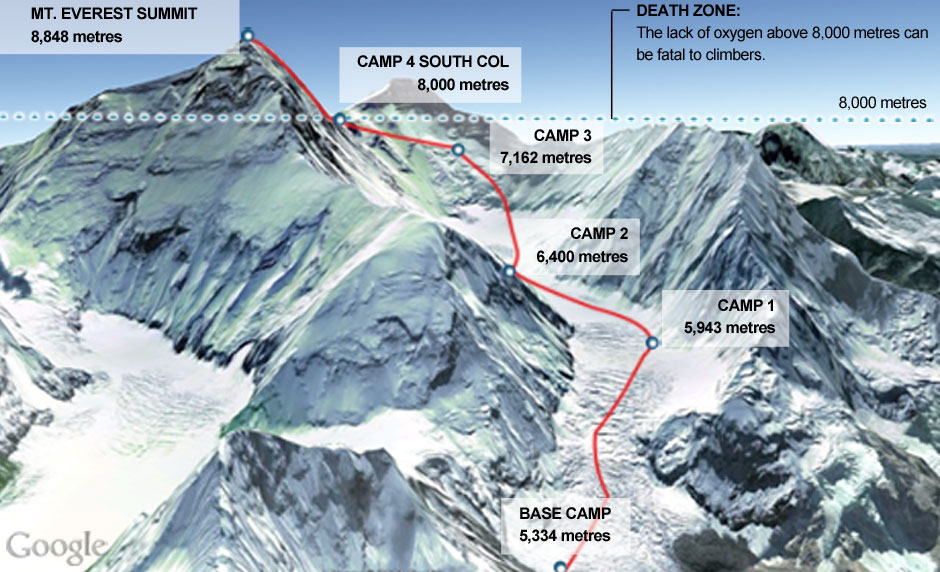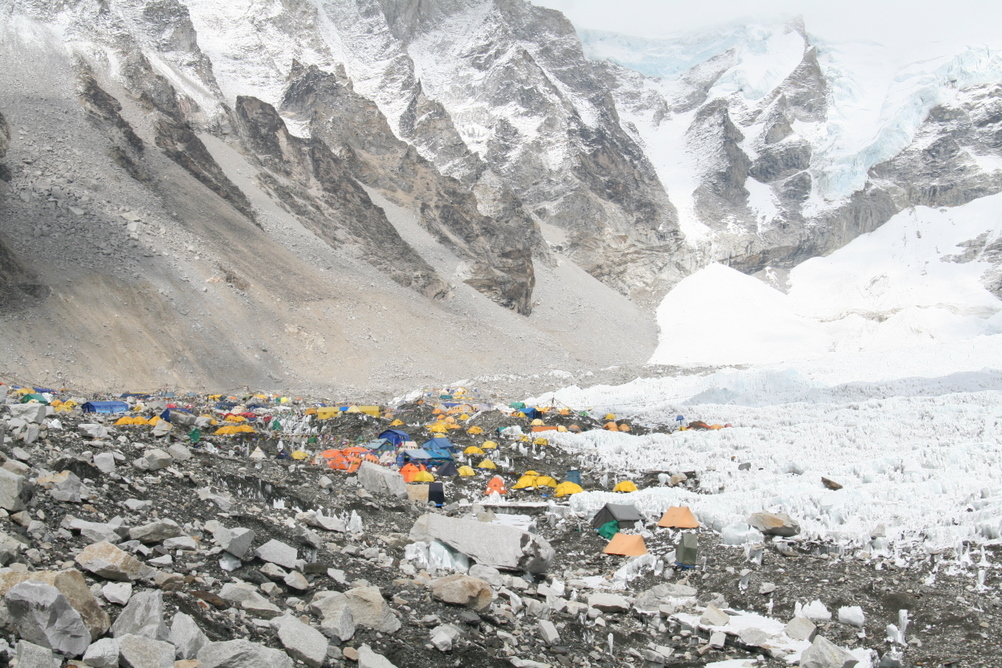You say you want to climb Mount Everest? Wind gusts on the world’s highest peak last week were clocked at 70 miles per hour. Air temperatures were minus 40 degrees Fahrenheit.
More than 370 foreigners assembled on the south side of Everest weeks ago, aiming to acclimate their bodies to high altitudes and bitter cold. They are accompanied by an equal number of local guides and porters, mainly courageous Sherpas who assume enormous personal risks, far greater than their clients. More on this shortly.
Weather patterns this time of year are as good as it gets for making an ascent. May is climbing season on Everest. Periods of high winds, bone-chilling cold – yes, but not so much snow. Usually. But not this year, this week. Latest forecasts cite potential for up to two feet of snow near the peak every day.
Most expedition groups planned to be on the move this week in northeastern Nepal’s Khumbu District, working their way higher from base camp (photo above, from May, 2008). But the daunting weather conditions have forced most to hunker down in tents where they are, either in high camps or at base camp.

Once these expedition teams do begin the ascent, weather permitting, we can expect unfolding scenes in the next few weeks of hundreds of climbers converging. Human traffic jams. Conga lines. Hours-long delays that put the health of climbers and their Sherpas at even greater risk. Groups descending, groups rising along the same narrow, extremely treacherous trail.
The south route that hundreds of people do complete most every year essentially follows the one that Edmund Hillary and Tenzing Norgay forged on their historic first ascent on May 29, 1953. But the comparison of Hillary and Tenzing’s achievement to what is happening now ends there.
Almost every step in 2017 will be choreographed along miles of fixed ropes secured by Sherpas who routinely work precariously within a few feet, or less, of what they know could be a fatal plunge, thousands of feet. They are guides, porters, care-givers and, frequently, rescuers for the foreigners on their sacred mountain.
Most of these Sherpas — men and women – carry haunting memories of someone, a friend or perhaps even a family member, who died while laboring on Everest.
What Sir Ed and Tenzing accomplished was the mid-20th century equivalent of the following generation’s quest to put a man on the moon. Seven major expeditions over the prior three decades had failed, including one mounted by Swiss climbers a year before in 1952.
“Even using oxygen, as we were, if we did get to the top, we weren’t sure whether we would drop dead,” Sir Ed said years later.
Various sources cite different figures for fatalities on Everest, but all are ghastly.
According to government statistics, around three hundred people perished from 1953 through 2015. Roughly four thousand have reached the summit.
In a country as poor as Nepal, Everest Inc. puts a lot of money into many pockets. It is the wellspring of Nepal’s $370 million trekking-and-tourism industry.
The majority of climbers on guided expeditions are tourists, really, who pay $65,000 or more with the full expectation they will succeed and return safely. Many have never climbed a mountain half as high as Everest (29,029 feet), or worn ice crampons. Some even fix crampons to the wrong feet. Tighter rules, including requiring climbers to have ascended a peak of at least 21,000 feet, have not been approved.
It is immoral that so many novice foreigners each year expect to amuse themselves in high-altitude adventure. They are exploiting Sherpas and other Nepali mountaineers who risk their lives for so little compensation.
In 2013, more than 450 people made it to Everest’s peak, about double the number in 1990. This was before 35 guides and climbers, including 23 Sherpas, perished along the climbing trails from horrific avalanches in 2014 and 2015.
The Nepali government issues too many permits for Everest because expedition companies, most based in the United States and Europe, keep the money flowing. This year, after usual attrition related to illness, injury, and fear, more than 300 expedition tourists likely keep the vigil. The government collects $11,000 for each permit.
But how much of that money do the Sherpas see? An abysmally low share of Everest Inc. money reaches the Sherpas and other local guides and porters who bear the heavy loads and biggest risks.
Guides on the staff of Western expedition companies often make $50,000 in a climbing season, but top pay for Sherpas, who must make many more trips, is only $5,000. Yet this $5,000 is roughly ten times the average per capita income in Nepal. It’s easy to understand why, for nearly all Sherpa guides, working with expedition companies is the best opportunity they likely will have to give their families better lives. Regardless of the risks.
Next week we’ll look at the exploitation of Sherpas, and if anything can be done to halt it, through the eyes of a son of Tenzing Norgay, my friend and colleague for more than twenty years in the American Himalayan Foundation, Norbu Tenzing Norgay.
Photo of Everest Base Camp courtesy of Ilker Ender.
Everest Summit Map courtesy of CBC.


Leave a Reply